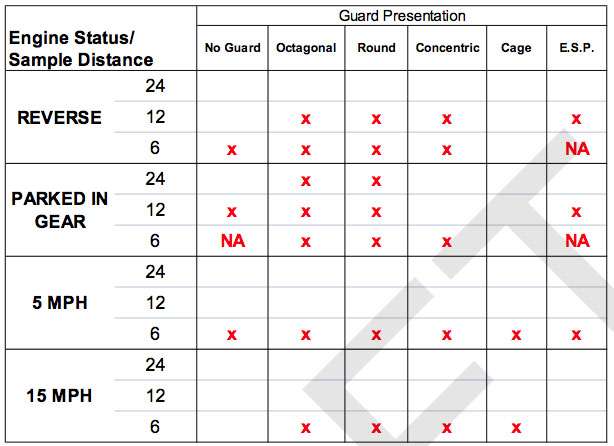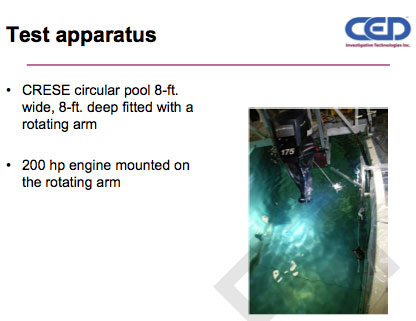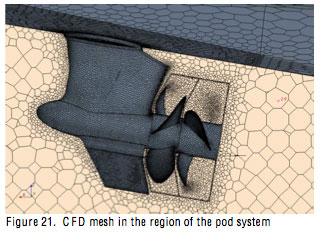The Emperor Has No Boat – SUNY Propeller Guard Testing
We took the liberty of capturing a few seconds of video from one the tests ran at SUNY many years ago that used to be posted on their web site. It shows the general layout and the rotating arm with the outboard mounted to it with the outboard’s propeller sticking down into the water.
On September 29, 2010 CED presented their preliminary results of their human factors testing of propeller guards at IBEX (a large boating industry trade show) during the Accident Mitigation Workshop: Carbon Monoxide and Propeller Injury Avoidance Meeting sponsored by the U.S. Coast Guard and put on by the American Boat and Yacht Council (ABYC). The human factors testing consisted of cylindrically forming ballistic gelatin to lengths of PVC pipe and suspending them in CRESE’s tank at certain horizontal distances from the center line of the propeller as the drive rotated by, as the drive was stationary, or as the drive was reversed. The test specimens looked a little like wind chimes suspended in the water. Observations were recorded as to which of the chimes was struck and the severity of damage to the chime for each guard being tested at a range of forward speeds, stationary, and in reverse. Similar data was collected for an exposed propeller. The collection of data for an exposed propeller is a bit interesting, as back in the 1990 testing, Mercury Marine was very adamant that absolutely no testing of exposed propellers was to conducted at SUNY.
CED presented another round of human factors propeller guard test data at the Miami International Boat Show on February 17, 2011 during the Accident Mitigation Meeting: Carbon Monoxide and Propeller Injury Avoidance held there. This time they released data from testing the Australian Environmental Safety Propeller and some additional test data on Guy Taylor’s 3PO guard.
Both times CED summarized their human factors propeller guard test data as a matrix showing the conditions on the left side (reverse, parked in gear, 5 mph, 15 mph) with the type of guards listed across the top. CED placed a red “X” in the cells in which the chime showed impact. The chart from their February 17, 2011 presentation is provided below. We are not swearing our identifications of guard manufacturers are correct, but from the photos they look like:
No Guard = Exposed propeller
Octagonal = Guy Taylor’s 3PO guard
Round = Adventure Line Guard
Concentric = Prop Guard by Prop Guard Marine
Cage = MariTech SwimGuard
ESP = Australian Environmental Safety Propeller
The SUNY CRESE test apparatus primarily consists of a large rotating arm that suspends the outboard motor over a circular tank filled with water. The test apparatus can be seen in the video above, and in the photo below supplied by CED during their February 17, 2011 presentation at the Miami International Boat Show.
Is their anything missing in these images? The Emperor has no boat! All the testing was done without a boat hull. While SUNY provides a great place to do nice consistent, repeatable testing, the data collected there IS NOT useful for predicting contact with the chimes because no boat hull was used.
CED went straight from the old cadaver body part propeller guard impact tests ran at SUNY, to implying their their human factors testing is a reliable indicator of the probability of a given guard impacting a chime at a specific distance from the centerline of the propeller out in the real world outside the SUNY tank. They also imply that probability is directly comparable to the probabilities of contact with other guards in the real world developed during the same SUNY tests.
The only usefulness of their probability data is to divers in the SUNY tank as the outboard goes by them. It is not relevant to the real world because their test apparatus did not include a boat hull. The Emperor Has No Boat.
Streamlines, propeller intake pressures, and propeller exist pressure patterns are not the same with and without a boat hull. Those pressures and streamlines play a large role in determining if the guard will strike the chime or not.
Look behind your boat while you are going across the lake. You see the overlaying of three primary wake patterns: the boat hull, the wake of the drive, and the jet out the back of the propeller. The largest of those patterns is the boat hull. It was not even present in the SUNY testing. The Emperor Has No Boat.
Just type propeller hull interaction into Google and you will see countless technical articles on the hydrodynamic interactions between boat hulls and propellers. Another area of related study is hull, propeller, rudder interaction.
Certain types of boats tend to be involved in certain types of propeller accidents, such as houseboats striking people when reversing from shore. The houseboat is in shallow water and the propeller may actually be recirculating some of its flow as you begin to reverse (flow exits the prop then swings out, around and back forward to come through again because little water is available under the boat. The prop is sucking the water out from under the boat, the boat may actually squat some at the stern, and water may be recirculating through the prop until the boat comes up to speed in reverse. Those types of factors have a lot of effect on whether a chime would be pulled in or not.
Even in open water in reverse, a boat hull has tremendous effect on propeller pressures and streamlines. The upper part of the propeller is pumping at least a portion of its water at the hull and its output is restricted. The bottom half of the propeller is running with less restrictions on its exit. The boat hull is influencing pressures and streamlines which would influence a chime being hit or not.
Those defending testing without a boat hull might say, okay, so boat hulls influence pressures and streamlines. Their impact would be equally felt by all the guards we tested so our data is still at least a relative indicator of a strike or not. No, the various guards themselves effect propeller streamlines and pressures in their own way. The system of guard + propeller + drive + hull creates a unique set of streamlines and pressures for each of those combinations.
We find it humorous that the industry always argues in legal cases that any testing has to be done with the EXACT SAME boat that was involved in the accident and strongly rejects any testing done by victims lawyers using the same model and year of boat, just not the exact same boat. Now they leave the boat out all together and say the system represents all boats. The Emperor Has No Boat.
A few more points:
- We see absolutely no efforts to correlate the amount of damage to a chime to injury severity.
- We see absolutely no efforts to correlate whether a chime is struck or not in the tank to a person being struck or not in the real world (outside the tank) OR for that matter even efforts to correlate whether a chime would be struck in the real world or not.
- We see no discussion of how they selected the exact lengths, position, and construction of the chimes AND how sensitive those variables are (like if the hanging chimes were 1 inch longer would all the results be different?)
- We so no efforts to correlate the chimes to real body parts OR to correlate their impact damage to impact damage on real body parts.
- The U.S. Navy has a huge laboratory facility called Carderock. I have been there a few times. They have a huge model test basin that may be large enough to handle small boats. The test basin is normally used for ship scale models, but might be capable of full size testing of propeller guards mounted on small boats. I seem to recall them testing some full scale small boats in the past.
- Computational Fluid Dynamics (CFD) is another route. Modeling the drive, propeller, guard, and hull could produce useful a useful system model that could be easily adapted to different components. We have been calling for work in this area for years. Mercury Marine presented a talk titled, Validated Planing-Hull CFD Simulations at Mercury Marine, at a technical conference called STAR Global Forum 2009. It is obvious they are working in this area, they just need to add another project with a little different focus. If you do not think they are close, you might want to look at Figure 21 from a paper titled, “Use of Commercial CFD Codes to Enhance Performance Prediction Capabilities for Planing Boats.” It was presented by three Mercury Marine employees at the Second Chesapeake Power Boat Symposium in March 2010. They have already modeled boat hulls, drive gear cases, propellers, pod drives, and even contra-rotating propellers and put it all together. Mercury Marine has validated its CFD results against real world tests and are seeing good agreement. They did this using off the shelf Computational Fluid Dynamics software and codes. One interesting section of their 2010 paper is titled, “Propeller/Pod/Hull Interaction”. Does that sound applicable to modeling propeller guard interactions? Did I mention they have also been modeling the flow around trim tabs?
- CED and SUNY / CRESE present minimal materials about the actual operation of the test apparatus. It is not obvious if the rotating arm is being powered by the outboard or if the arm is powered and dragging the outboard through the water. If the arm is powered, the flows around the propeller could be significantly different than in real life. Streamlines and pressures around the propeller are different if the boat is being drug through the water vs. being powered by its propeller.
We noticed one reference to our concerns in the minutes of the February 17, 2011 Accident Mitigation Meeting.
“A brief questions and answer secession (sic) ensued. The question was posed whether a boat hull would create different outcomes. The intent of the protocol was to identify opportunities for propeller contact in a controlled environment. A discussion ensued about the use of live boat testing. The consensus was there may be value in determining the hull interference in propeller strikes.”
The emperor has no boat!



